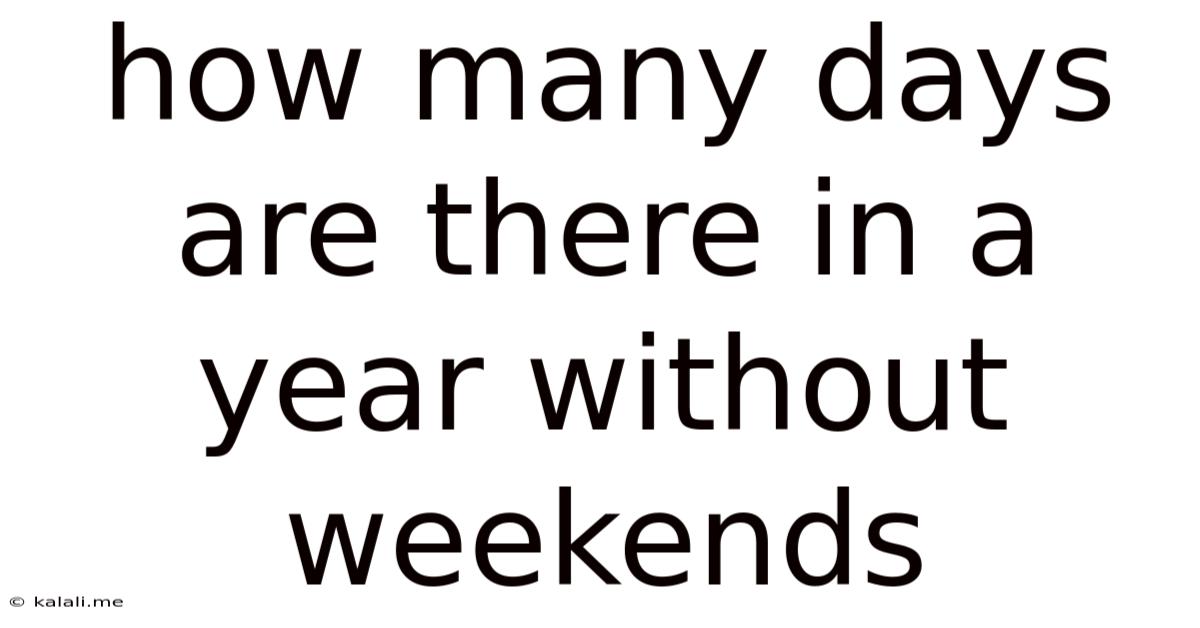How Many Days Are There In A Year Without Weekends
Kalali
Aug 20, 2025 · 4 min read

Table of Contents
How Many Days Are There in a Year Without Weekends? A Deep Dive into Working Days
This question, seemingly simple at first glance, delves into the fascinating intersection of calendar systems, work schedules, and the ever-present desire to maximize productivity. Determining the precise number of days in a year excluding weekends requires a nuanced understanding of leap years, varying calendar structures, and the definition of "working days" itself. This article will explore these intricacies, providing a comprehensive answer and delving into related concepts useful for project planning, scheduling, and general calendar awareness.
What We'll Cover:
- Understanding the Basic Calculation
- The Complication of Leap Years
- Variations in Work Schedules and Holiday Considerations
- Calculating Working Days Across Different Calendar Systems
- Practical Applications and Tools for Calculating Working Days
- Beyond the Numbers: The Importance of Work-Life Balance
The Basic Calculation: A Starting Point
The most straightforward approach involves recognizing that a standard year has 365 days. A week has 7 days, with 2 being weekends (Saturday and Sunday). Therefore, there are 5 working days per week. A seemingly simple calculation would be:
365 days / 7 days/week * 5 working days/week ≈ 260.7 working days
This gives us an approximate number. However, this calculation ignores a significant factor: leap years.
The Leap Year Factor: Adding an Extra Day of Complexity
Leap years, occurring every four years (with exceptions for century years not divisible by 400), add an extra day to the year, February 29th. This seemingly small addition significantly impacts the calculation of working days. In a leap year, the equation becomes:
366 days / 7 days/week * 5 working days/week ≈ 261.4 working days
Beyond the Basics: Incorporating Holidays and Variable Work Schedules
The above calculations provide a reasonable approximation, but they lack real-world accuracy. Most work schedules incorporate public holidays and other non-working days. The number of holidays varies significantly across countries and cultures. For example, some countries celebrate numerous religious holidays, while others have fewer. Similarly, the inclusion of bank holidays, national observances, and company-specific days off further complicates matters.
To account for holidays, one must subtract the number of holidays from the total number of working days previously calculated. For a country with, say, 10 public holidays, the adjusted calculation for a non-leap year would be:
260.7 working days - 10 holidays = 250.7 working days
Similarly, atypical work schedules, such as those with rotating shifts, compressed workweeks, or part-time arrangements, need to be considered individually. There's no single formula to accommodate all these variations.
Calculating Working Days Across Different Calendar Systems
While the Gregorian calendar is the most widely used internationally, other calendar systems exist, each with its own structure and implications for calculating working days. Islamic, Lunar, and other culturally specific calendars introduce additional complexity. The calculation requires a deep understanding of the specific calendar system's rules for determining weekdays and holidays. Generic formulas won't work. Specialized software or manual calculation based on the specific calendar is usually needed.
Practical Applications and Tools for Calculating Working Days
The need to accurately calculate working days arises in various professional settings:
- Project Management: Accurately estimating project timelines requires knowing the available working days.
- Payroll Processing: Calculating employee compensation often depends on the number of days worked.
- Financial Modeling: Predicting cash flow or assessing investment returns might involve factoring in working days.
- Scheduling and Resource Allocation: Optimizing resource utilization often relies on accurate working day calculations.
Several online calculators and software programs are available to assist with this task. These tools usually allow you to input a start date, an end date, and relevant holiday information to generate a precise number of working days. Spreadsheet software like Microsoft Excel or Google Sheets also provide functions for these calculations. However, the accuracy of any tool relies on accurate input of relevant data.
Beyond the Numbers: The Importance of Work-Life Balance
While accurately calculating working days is crucial for operational efficiency, it's equally important to remember the human element. An overemphasis on maximizing working days can lead to burnout and decreased productivity. A balanced approach that prioritizes employee well-being and work-life integration should be prioritized. Regular breaks, sufficient vacation time, and a culture that respects personal time are critical for sustainable productivity. The simple number of working days doesn't encapsulate the complexities of a productive and healthy work environment.
Conclusion: A Dynamic Calculation
Determining the exact number of days in a year without weekends is not a static calculation. It's a dynamic process that needs to account for leap years, holidays, variations in work schedules, and the chosen calendar system. While approximations can be useful, for accuracy, one must incorporate all relevant factors, potentially using specialized tools or meticulously manual calculations. Beyond the numbers, however, lies the crucial importance of maintaining a healthy work-life balance, ensuring that the pursuit of efficiency doesn't compromise the well-being of individuals and teams. The ideal is not just maximizing working days but maximizing productive and fulfilling working days within a sustainable framework.
Latest Posts
Latest Posts
-
Why Did The Cow Want A Divorce Answer Key
Aug 20, 2025
-
How To Create Void On Doodle God
Aug 20, 2025
-
What Is 20 Percent Of 250 000
Aug 20, 2025
-
What Color Does White And Blue Make
Aug 20, 2025
-
Can Red Velvet Cake Cause Red Poop
Aug 20, 2025
Related Post
Thank you for visiting our website which covers about How Many Days Are There In A Year Without Weekends . We hope the information provided has been useful to you. Feel free to contact us if you have any questions or need further assistance. See you next time and don't miss to bookmark.